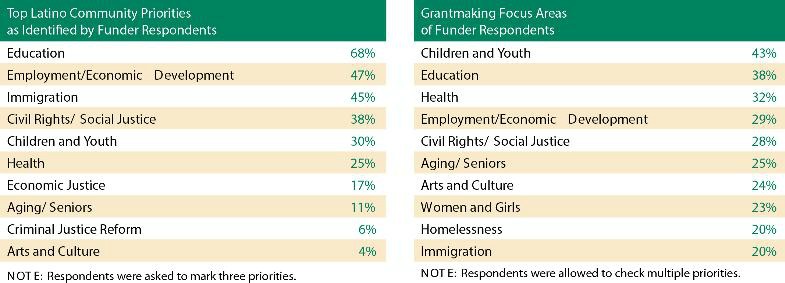On April 27, 2012 at the HIP GameChangers Conference in Los Angeles, HIP released a new report analyzing potential root causes of foundation under-funding of Latino nonprofits. The report, completed by Dr. Aida Rodriguez of Milano The New School for International Affairs, Management and Urban Policy, provides a starting point for understanding exactly where the gaps and opportunities exist for increasing grantmaking to Latino-led, Latino-serving nonprofits over the next decade. Dr. Rodriguez analyzes the results of two surveys–one of HIP’s funding partners and members and another of HIP’s grantees–and recommends strategies for moving forward. Below are four of the report’s major findings.
1. Grantees and Funders Generally Aligned in Priorities for Latino Communities. Both funder and grantee respondents identified Education, Economic Development, Immigration, and Civil Rights as the most pressing issues for philanthropy to address in Latino communities. The report makes the point that this alignment “is to some degree a testament to HIP’s success in building a network in philanthropy of Latinos and allies with a strong understanding of Latino communities.”

2. Despite Shared Understanding of Priorities, Many Obstacles to Aligning Actual Grantmaking Practices. While the grantee and funder respondents generally aligned in what they see as priorities for Latino communities, the funder respondents self-reported that the actual grantmaking practices of their foundations did not match these priorities. One-third of funders said that they were unable to provide funds to Latino organizations because of narrowly focused grantmaking practices while others noted difficulty in finding Latino organizations within their program area.

3. Strong Need for General Operating and Capacity Building Support among Latino Nonprofits. In the words of one respondent, “Funders do a great job of supporting programs. I think it would be great though if funders supported more on the back half of the house – administration, accounting, and the behind the scenes parts of nonprofits that make them strong. At the end of the day we are a business and we need support from funders not only to run our programs but to run our business so that we are successful in good times and bad.”
4. Institution-Wide Engagement Crucial for Increasing Funding of Diverse Communities. Since individual program officers being aware of Latino community needs has not led to a shift in funders’ grantmaking, it is clear that wider institutional engagement is required. Potential barriers to institution-wide engagement include program officers not feeling empowered to change the status-quo and skepticism toward funding small grassroots organizations.
These four insights are just a glimpse of the findings explored in the twenty-page report. The report concludes with some recommendations for both funders and for HIP, including an emphasis on strategies that better link donor intent with grantmaking strategies that specifically target Latino communities. The report shows that there is agreement on major priorities for Latino communities; the next step is developing institution-wide funding strategies that intentionally address those priorities while still remaining true to donor intent.
The report follows up on HIP’s December 2011 report released in partnership with the Foundation Center, which found that foundation funding for Latino organizations and programs has remained stable at about 1.3 percent over the past 10 years.
Read the full report “Foundation Funding and Latino Community Priorities: Gaps and Opportunities”
